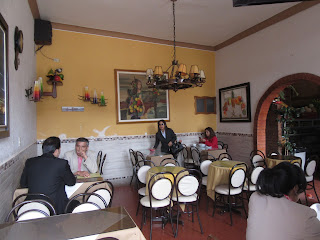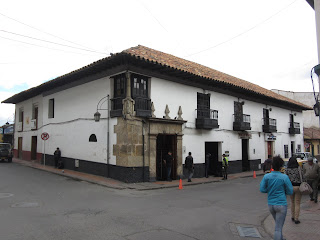After another mouth-watering breakfast at our hotel in Villa de Leyva, we
arrived in the neighboring town of Tunja
by about mid-morning. The city, founded by Gonzalo Suarez Rendon in 1539 on the site of Hunza, the pre-Hispanic Muisca
settlement, was the capital of the state of Boyaca and a bustling student center. We wanted to visit Tunja because I had read the city was a trove of colonial-era churches noted for their Mudejar art, an
Islamic-influenced style developed in Christian Spain between the 12th and 16th centuries.
We walked directly to the historical center of the city and saw the Iglesia de Santo Domingo which was built in 1560.
Another stunning side chapel:
The opulent main altar was carved in gold-painted wood and depicted scenes from the life of Santo Domingo. The oil painting at the top was of Holy Ecce Homo dating from the 18th century.
This was the first time we had seen recycling containers in church.
St. Thomas University, located next door, was the first of several colleges and universities we saw in Tunja.
After walking to Templo Santa Barbara next and finding it closed, we strolled along a pedestrian mall which headed directly into the main square called, naturally, Plaza Bolivar!
Historical Tunja, including the cathedral, was declared a National Monument of Colombia in December, 1959.
A plaque on the corner building as we entered the plaza honored the city's independence from Spain. It must have had government offices as there was a significant police presence in front of it.
There was a large barricade around Bolivar's statue, unfortunately, which prevented everyone from getting a decent shot of it.The Renaissance-style Cathedral Basilica of St. James the Apostle, also simply called Tunja Cathedral, was the oldest cathedral in Colombia and built in 1598. It had a single tower and its interior consisted of three naves with side chapels.
The large signs on either side of the Cathedral's main door announced upcoming funeral Masses.
Somehow, we had timed our arrival just as Mass
was ending - that seems to have been our pattern of later! The simple interior highlighted the original 16th century mix of Elizabethan gothic arches and Moorish ceiling.
Two more exquisite chapels:
We were so happy that this chapel had the beautiful mudejar ceiling as we'd made the day trip to Tunja specifically to see church ceilings like that.
I loved this shot from the Cathedral through to the main square.
Another view of the square from the front of the Cathedral:
Immediately next to the church was a charming café that peeked my head (and camera, obviously) into but neither of us are normally café-type people and we had other places we hoped to see.
There was no sign out front but this doorway next to the café had to be the Casa del Fundador Suarez Rendon but it was closed up tight. We had hoped to visit it as it was supposed to have been one of the
colonial mansions that had ceilings featuring a strange mishmash of motifs
taken from very different traditions.
So, instead we walked toward another colonial mansion, Casa de Don Juan de Vargas. As you can see, much of the city was quite hilly, so we got our exercise traipsing uphill and downhill looking for churches that were open!
I cannot believe I didn't buy any of these strawberries as they looked so yummy and were sold on so many street corners, too. But we stopped for a bite to eat at one of the countless chicken restaurants. Afterward, we retraced our steps to the Casa by the Cathedral, hoping it would be open after lunch time. Unfortunately, it wasn't open to visitors then either.
St. Ignatius Church was likewise closed! We know that
museums around the world are often closed on Mondays but we never imagined that
most churches in Tunja would likewise be closed on Mondays.
We tried again to see St. Barbara Church but discovered it was only open at 6 unfortunately for nightly Mass. Our visit to Tunja seemed like pretty much of a bust until we took a chance of finding the Capilla y Muse de Santa Clara La Real or St. Clara Chapel and Museum open.
It was a fair distance away so we had an interesting walk seeing other 'attractions' on the way.
Some of the old colonial buildings were very appealing from the outside.
I read that this hotel was supposed to have had 'smartly furnished rooms surrounding a pleasant courtyard.' Sounded nice if we'd had an extra night to spare in town AND churches and other sights had been open!
At last we found the Museo de Santa Clara but it, too, looked like it was locked up tight.
Steven knocked on the door, rang the doorbell and finally
was rewarded for his efforts when it was opened by a teenage boy.
We knew our luck had changed not only when he spoke pretty decent English but the nominal admission included his taking us on a tour of the chapel and museum! When we asked why the front door had been closed, he mentioned that there was no money to pay police to keep watch over the chapel and museum.
He explained that a childless Spanish couple had this large
home in 1571 and, when the couple divorced, the wife sought and received permission from the pope to open the home as the first convent house and church in Colombia.
The nuns distributed food daily for the needy of Tunja from this window, our guide explained.
He said this was a picture of what the original Guadalupe looked like when
she came from Spain in the 17th century. I didn't know who Guadalupe was though, let alone the original one!
This little, windowless room was where Sister Francisca Josefa, Colombia's version of Mother Teresa, slept by herself for 53 years. Normally, 15-20 nuns slept together but she was illiterate. Our young guide explained she had a mystical
connection with God and miraculously learned to read and write.
The Mother Superior’s office contained a 15th century
painting made from eggs and plants.
The Spanish Conquistadors believed people could see their
spirits in the mirrors and therefore removed them from the gold frames.
Sr. Josepha’s study included a 400-year-old desk.
She used this minuscule space, more of a cubbyhole really, next to her office to
flagellate herself as she felt that with all her emotions of hunger and anger,
etc, she was far from God and therefore needed to hurt herself to become closer
to God. This was our first glimpse of the church. We could hardly wait to see more of it.
The wall in front of her desk looked perfectly blank until
our guide turned out the light and we could see poems the nun had written on
the wall as she had no paper!
The choir area, which overlooked the chapel or church but was not visible from below, was where the voices of all 200 nuns became
one, our guide stated.
The floors felt every bit of their 450 or so years of age as we tread softly over them.The gorgeously decorated choir ceiling:
There were two altars in the choir space because competing Mother
Superiors each wanted their own! The yellow one was the newer one and partially blocked the older, red one, our guide explained.
At last our tour took us to the long-awaited chapel which was built using three
different styles: Gothic, Baroque and Mudejar.
This was the location of the original altar but Sr. Josepha
changed it to the current central spot.
The angel in the center of each of the six stars represented the cardinal points for the ‘natives’ aka indigenous peoples.
The portrait in the center was of the founder of the convent. When
The young man explained that the chapel and museum received no money from the government or archdiocese and that they only survived on donations from tourists. IF we understood him properly, it sounded like his family was solely responsible for upkeep of the beautiful shrine dedicated to Santa Clara.
The museum and chapel tour had been a hidden gem. Our guide, his parents and sister provided tours but he was the only one in his family who spoke English. What luck that high school had ended for the day and that he’d been the one who had answered the door. for us. Unfortunately, it wasn’t surprising to learn they had only had four tourists in all of September because the entrance didn’t look inviting and welcoming.
I read that Tunja was overlooked by travelers intent on
rushing on to Villa de Leyva but it would have been a loss to have missed
seeing this site in particular. If the other casas and churches had also been
open, they would have been the proverbial cherry on top. We walked ten minutes down to the station and hopped on a
bus a few minutes later to return to Villa de Leyva.
Next post: Hiking to discover petroglyphs just an hour later.
Posted on October 7th, 2017, from Guayaquil, Ecuador.





































































No comments:
Post a Comment